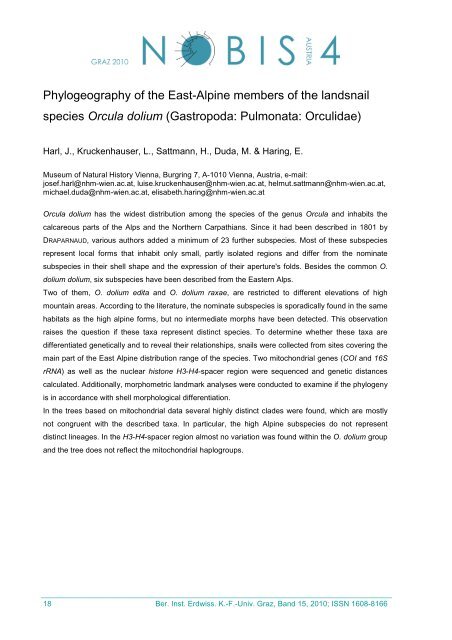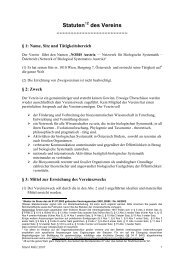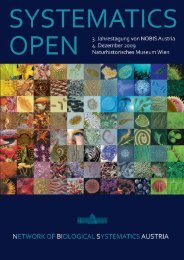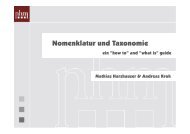4. Jahrestagung von NOBIS Austria 2. - 3. Dezember 2010
4. Jahrestagung von NOBIS Austria 2. - 3. Dezember 2010
4. Jahrestagung von NOBIS Austria 2. - 3. Dezember 2010
You also want an ePaper? Increase the reach of your titles
YUMPU automatically turns print PDFs into web optimized ePapers that Google loves.
Phylogeography of the East-Alpine members of the landsnail<br />
species Orcula dolium (Gastropoda: Pulmonata: Orculidae)<br />
Harl, J., Kruckenhauser, L., Sattmann, H., Duda, M. & Haring, E.<br />
Museum of Natural History Vienna, Burgring 7, A-1010 Vienna, <strong>Austria</strong>, e-mail:<br />
josef.harl@nhm-wien.ac.at, luise.kruckenhauser@nhm-wien.ac.at, helmut.sattmann@nhm-wien.ac.at,<br />
michael.duda@nhm-wien.ac.at, elisabeth.haring@nhm-wien.ac.at<br />
Orcula dolium has the widest distribution among the species of the genus Orcula and inhabits the<br />
calcareous parts of the Alps and the Northern Carpathians. Since it had been described in 1801 by<br />
DRAPARNAUD, various authors added a minimum of 23 further subspecies. Most of these subspecies<br />
represent local forms that inhabit only small, partly isolated regions and differ from the nominate<br />
subspecies in their shell shape and the expression of their aperture's folds. Besides the common O.<br />
dolium dolium, six subspecies have been described from the Eastern Alps.<br />
Two of them, O. dolium edita and O. dolium raxae, are restricted to different elevations of high<br />
mountain areas. According to the literature, the nominate subspecies is sporadically found in the same<br />
habitats as the high alpine forms, but no intermediate morphs have been detected. This observation<br />
raises the question if these taxa represent distinct species. To determine whether these taxa are<br />
differentiated genetically and to reveal their relationships, snails were collected from sites covering the<br />
main part of the East Alpine distribution range of the species. Two mitochondrial genes (COI and 16S<br />
rRNA) as well as the nuclear histone H3-H4-spacer region were sequenced and genetic distances<br />
calculated. Additionally, morphometric landmark analyses were conducted to examine if the phylogeny<br />
is in accordance with shell morphological differentiation.<br />
In the trees based on mitochondrial data several highly distinct clades were found, which are mostly<br />
not congruent with the described taxa. In particular, the high Alpine subspecies do not represent<br />
distinct lineages. In the H3-H4-spacer region almost no variation was found within the O. dolium group<br />
and the tree does not reflect the mitochondrial haplogroups.<br />
_____________________________________________________________________________<br />
18 Ber. Inst. Erdwiss. K.-F.-Univ. Graz, Band 15, <strong>2010</strong>; ISSN 1608-8166






